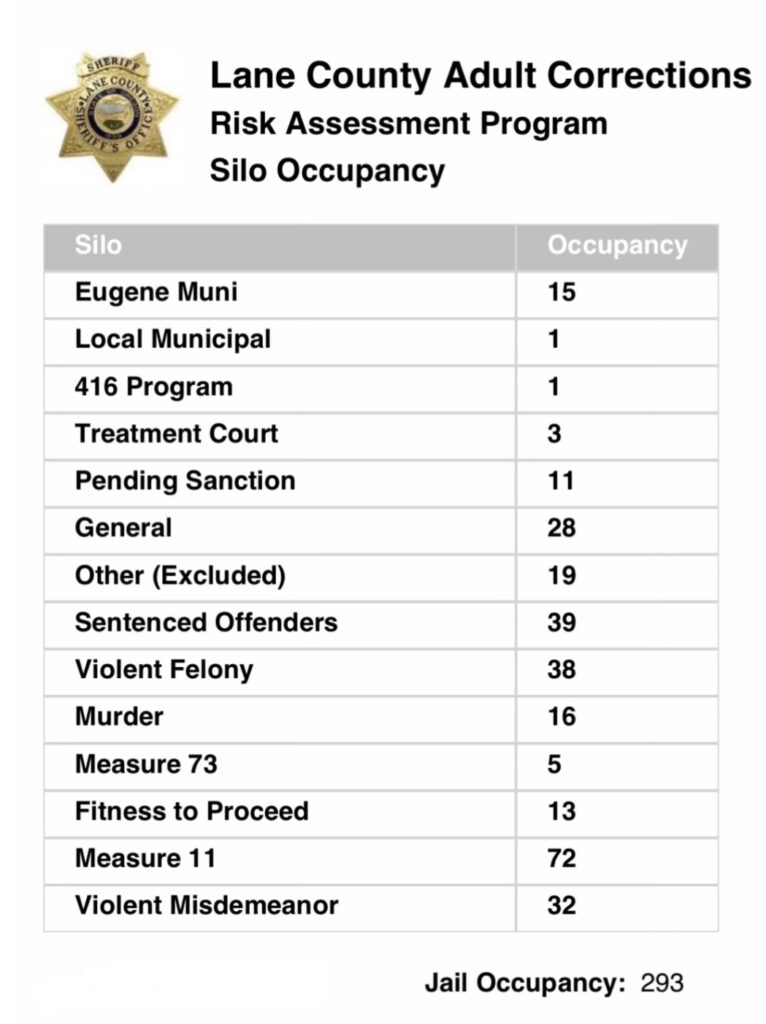While the population is the jail is continually changing depending on many factors including the courts, prosecution, judges, pre-trial release etc. This is a snapshot in time to give an idea of what the general population of our jail is.
A few important notes.
- The Sheriff does not control or decide who is in the jail. The population of the jail is controlled by the courts.
- The City of Eugene does not have a jail. The City rents fifteen (15) jail beds from the Lane County Jail to house municipal (non felony) offenders.
- The City of Springfield jail is for municipal offenders only – they cannot house violent felony offenders.
- As of 2021 – Lane County’s population was over 380,000 people. The Jail Levy provides funding for 255 jail beds – a fraction of what is needed for a population of almost 400,000 people.
Understanding the statistics.
- Eugene Muni – These are Eugene Municipal Offenders (non felony). These 15 beds are rented from the City of Eugene to house their municipal offenders. These individuals are housed based on a Eugene Municipal Court Judge’s orders.
- Treatment Court – These are beds utilized by the treatment court to impose sanctions on participants when needed as determined by a judge. (Lane County has a Drug Treatment Court, a Veteran’s Treatment Court, and a Mental Health Treatment Court.)
- Pending Sanction – These individuals are lodged in jail awaiting sanction by their Parole/Probation Officer for violating the conditions of their Parole/Probation.
- General – Pre-trial individuals lodged on such charges as property crimes, failure to appear, violation of release agreements from a previous lodging or lodged on a combination of municipal and Circuit court charges or out-of-County/State holds (non-violent).
- Other (Excluded) – Sentenced to State Prison, but brought back to Lane County to face additional or new charges, fugitive holds either other county or other state, etc. Also sentenced awaiting transport to an ODOC (Oregon Department of Corrections) facility.
- Sentenced Offenders – These are individuals who have made their way through the criminal justice system and have been sentenced to a time in jail (less than a year) by either a judge or a jury of their peers. *Generally, sentenced offenders are offered alternative ways to complete their sentences such as road crew or community service – these are individuals that had that opportunity and did not follow through.
- Violent Felony – These individuals are lodged on charges that constitute a violent felony (such as felony assault, strangulation, etc.), that is not included in Measure 11 (see below).
- Murder – These are individuals in jail on charges of Murder awaiting trial.
- Measure 73 – Measure 73 was approved by voters in 2010. One piece of Measure 73 required a 90-day jail term for a third drunk-driving conviction; these individuals were convicted and are serving that required jail sentence.
- Fitness to Proceed – These are individuals who are accused of a crime but may not be able to aid in their own defense due to mental health/cognitive issues. In these circumstances a judge orders a fitness to proceed evaluation to be completed at the Oregon State Hospital. These induvial are waiting to be evaluated by the courts to determine if they are fit to proceed in aiding in their own defense, or they are waiting for their next court date subsequent to receiving that evaluation.
- Measure 11 – You can read the entire list of crimes that fall under Measure 11 and their sentences here. Measure 11 offenses are violent person-to-person crimes, including murder, rape and child sex abuse. For the purpose of our jail population, murder charges are separated out from the rest of the Measure 11 charges; see above.
- Violent Misdemeanor – Most people in jail in this category are being charged with domestic violence.
Snapshot in time as of 11:00am 4/10/2023.
